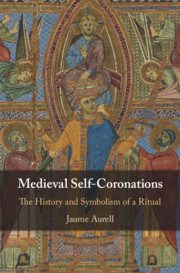Book contents
- Medieval Self-Coronations
- Medieval Self-Coronations
- Copyright page
- Contents
- Figures
- Acknowledgements
- Introduction
- 1 Self-Coronation As Ritual
- Part I Heritage
- 2 Consecration without Mediation in Antiquity
- 3 The Hand of God
- 4 Symbolic Self-Coronations in Byzantium
- 5 The Sacralisation of Carolingian Accessions
- 6 Anglo-Saxon and Ottonian Christocentrism
- Part II Infamy
- Part III Convention
- Index
2 - Consecration without Mediation in Antiquity
from Part I - Heritage
Published online by Cambridge University Press: 20 May 2020
- Medieval Self-Coronations
- Medieval Self-Coronations
- Copyright page
- Contents
- Figures
- Acknowledgements
- Introduction
- 1 Self-Coronation As Ritual
- Part I Heritage
- 2 Consecration without Mediation in Antiquity
- 3 The Hand of God
- 4 Symbolic Self-Coronations in Byzantium
- 5 The Sacralisation of Carolingian Accessions
- 6 Anglo-Saxon and Ottonian Christocentrism
- Part II Infamy
- Part III Convention
- Index
Summary
The second chapter explores diverse forms of mediation in pre-Christian civilisations, from the Israelite to the Mesopotamian, Egyptian, Persian and Greek monarchies, and the symbolic meanings connected with the idea of ‘consecration without mediation’. Based on textual, epigraphic and iconographical evidence, it privileges the analysis of the royal investiture ceremony in Achaemenid and Sassanid Persia, since the practice of self-coronation decisively influenced subsequent periods, reaching Islamic and even contemporary Persia (including the self-coronations of Shah Reza Pahlavi in 1926 and his son Mohammad Reza Pahlavi in 1967) and expanding beyond its borders, in Byzantium and central Asia.The objective of this chapter is try to find proof of the growing presence of the investiture and coronation ceremony in the images and narrations that have been preserved from antiquity, such as cave reliefs, coins, murals and historical texts. A natural consequence of the consolidation of this ceremony among the monarchies of the ancient civilisations was the multiplication of the ritual forms in which it appeared, and the consequent images that preserved the ceremony or imagined it. These images necessarily imply, regardless of whether they had a ceremonial reality, the unequivocal message of consecration-without-mediation of the sovereign, a resistance to priestly mediation.
Keywords
- Type
- Chapter
- Information
- Medieval Self-CoronationsThe History and Symbolism of a Ritual, pp. 61 - 84Publisher: Cambridge University PressPrint publication year: 2020

